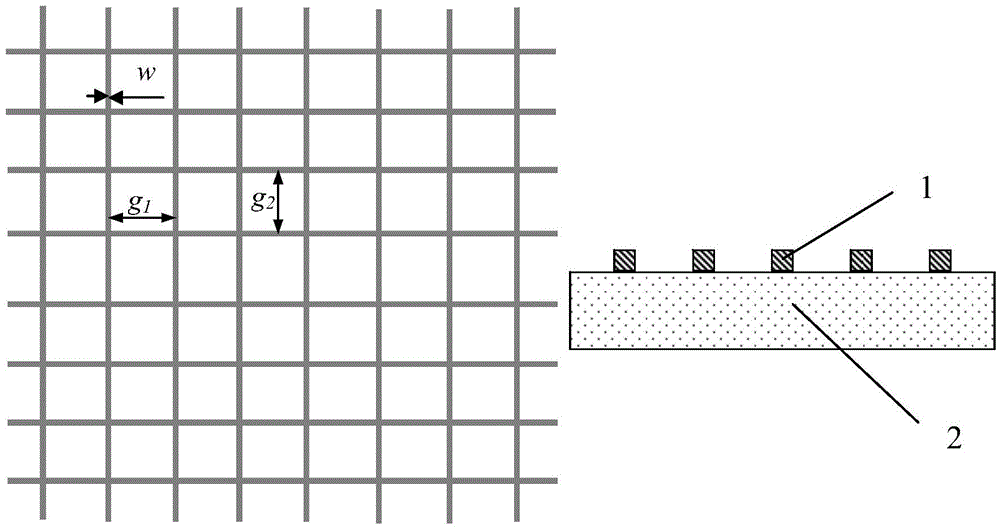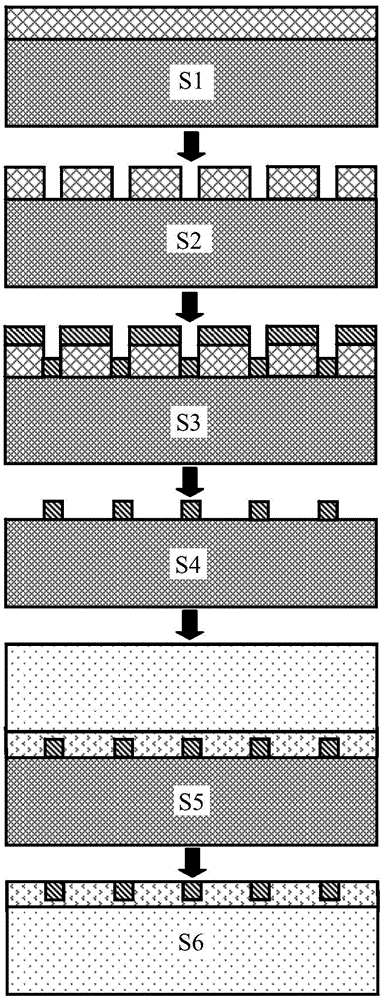Transparent electrode based on metal nanometer grid and preparing method of transparent electrode
A metal nano and transparent electrode technology, which is applied in the manufacture of circuits, electrical components, semiconductors/solid-state devices, etc., can solve the problems of unsatisfactory large-scale production, high price, and poor uniformity, and achieve easy integration and large-scale production. Integrated and mass-produced, structurally shape-tunable effects
- Summary
- Abstract
- Description
- Claims
- Application Information
AI Technical Summary
Problems solved by technology
Method used
Image
Examples
Embodiment 1
[0067] A transparent electrode based on a metal nanogrid is prepared by the following method:
[0068] according to figure 2 Shown process flow diagram, described method comprises the following steps:
[0069] Step 1: Spin-coat photoresist on silicon substrate and bake;
[0070] In this step, bake the cleaned silicon substrate on a hot plate at 180°C for 5-10 minutes, remove the moisture on the surface, spin-coat PMMA (German Allresist company) electron beam positive photoresist, and place it on the hot plate Bake at 180°C for 2 minutes;
[0071] Step 2: Exposure and development, etching the photoresist to form nano-grid patterns on the silicon substrate;
[0072] In this step, the PMMA on the silicon substrate is exposed by electron beam direct writing technology, and a nano-grid pattern is formed on the photoresist layer after development; MIBK (methyl isobutyl ketone) with a mass ratio of 1:3 is used The mixed solution of IPA (isopropyl alcohol) is used as developing s...
Embodiment 2
[0083] A transparent electrode based on a metal nanogrid is prepared by the following method:
[0084] according to figure 2 Shown process flow diagram, described method comprises the following steps:
[0085] Step 1: Spin-coat photoresist on thinned silicon substrate and bake;
[0086] In this step, after the silicon substrate is thinned to 200 μm, it is cleaned, and then placed on a hot plate and baked at 180°C for 5-10 minutes to remove the moisture on the surface, and spin-coat PR1-500A (Futurrex product of the United States) electron beam positive photoresist, and placed on a hot plate to bake at 110°C for 5min;
[0087] Step 2: Exposure and development, etching the photoresist to form nano-grid patterns on the silicon substrate;
[0088] In this step, the PR1-500A on the silicon substrate is exposed by optical lithography using projection lithography equipment, and a nano-grid pattern is formed on the photoresist layer after development; use DR6 (Futurrex Company of ...
Embodiment 3
[0099] A transparent electrode based on a metal nanogrid is prepared by the following method:
[0100] according to figure 2 Shown process flow diagram, described method comprises the following steps:
[0101] Step 1: Spin-coat photoresist on thinned silicon substrate and bake;
[0102] In this step, after the silicon substrate is thinned to 150 μm, it is cleaned, and then placed on a hot plate and baked at 180 ° C for 5 to 10 minutes to remove the moisture on the surface, and spin-coat PMMA (Germany Allresist Company) electron beam positive Glue, and bake on a hot plate at 180°C for 5 minutes;
[0103] Step 2: Exposure and development, etching the photoresist to form nano-grid patterns on the silicon substrate;
[0104] In this step, the PMMA on the silicon substrate is exposed by electron beam direct writing technology, and a nano-grid pattern is formed on the photoresist layer after development; MIBK (methyl isobutyl ketone) with a mass ratio of 1:3 is used The mixed s...
PUM
| Property | Measurement | Unit |
|---|---|---|
| thickness | aaaaa | aaaaa |
| thickness | aaaaa | aaaaa |
| width | aaaaa | aaaaa |
Abstract
Description
Claims
Application Information
 Login to View More
Login to View More - R&D
- Intellectual Property
- Life Sciences
- Materials
- Tech Scout
- Unparalleled Data Quality
- Higher Quality Content
- 60% Fewer Hallucinations
Browse by: Latest US Patents, China's latest patents, Technical Efficacy Thesaurus, Application Domain, Technology Topic, Popular Technical Reports.
© 2025 PatSnap. All rights reserved.Legal|Privacy policy|Modern Slavery Act Transparency Statement|Sitemap|About US| Contact US: help@patsnap.com


